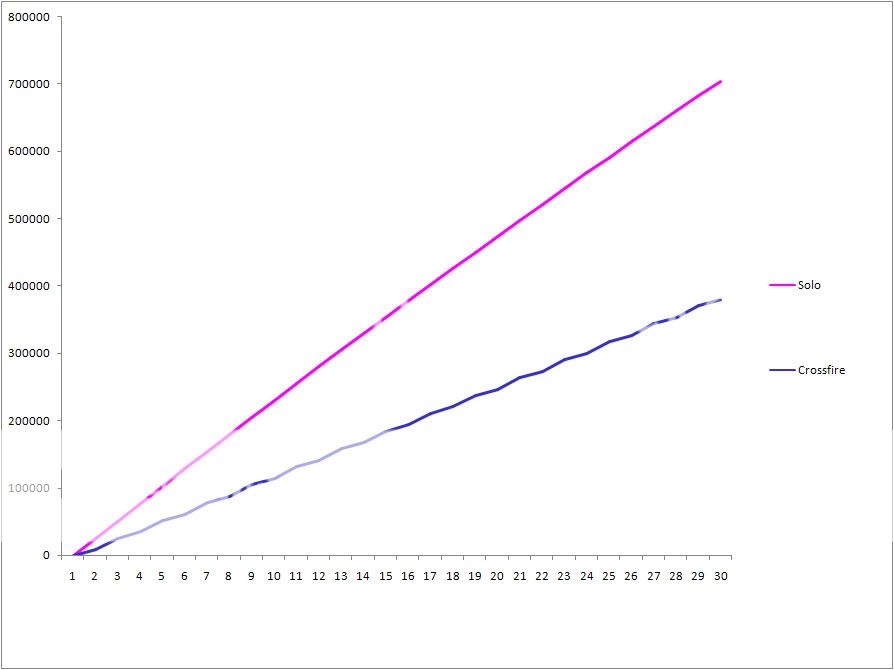Hard Forum wrote:
GPU "Microstuttering" FAQ
So everyones been posting about how an SLI or Crossfire rig, while managing to put out higher FPS than the single GPU solutions, does so while "Microstuttering". I'd like to clarify as much as I can around the issue, and hopefully you guys can help me out too. I don't have access to a multi GPU rig right now, so I'm going to go from what I learned about SLI and crossfire setups from my last rich customers dual 8800 build.
What is microstuttering?
When running two Graphics Processing units (GPUs) in tandem, via Crossfire or SLI, in Alternate Frame Rendering (AFR) mode, the two GPUs will produce frames asyncronously (for lack of a better term). Microstuttering can be expressed one way as your computer experiancing, in extreme rapid sucession, a high FPS, followed by a low FPS, followed by a high, then low, and so on.
The following is a chart of Frames VS Time, with time in nanoseconds (yeah, I have no idea why they used nanoseconds, but 100,000 [the first increment] is 0.1 seconds, or 100 miliseconds) in the Y-axis, and the frame count (NOT FPS) in the X-axis. The lower the bar, the higher the FPS.

Image taken from PC gamers hardware
As you can see, the crossfire setup, while getting out the same amount of frames (30) in less time (ie, while maintaining a higher FPS), has a certain wobble. This wobble is the phenomina known as microstuttering.
Here is another chart from anand found by Mega 666

Pulled from Anand
The Multi-GPU "Variance" is much greater than that of the Single GPU solution. The greater the difference from one variance to the next, the greater the stutter. The difference between the average variance and the variance at any one frame is the phenomina of microstuttering.
How does microstuttering impact me in game?
Microstuttering can make playing what fraps is calling a 60fps game feel identical to playing a 30 fps game (literally, this is a potential true case mathmatically).
Why does microstuttering happen?
It's a product of the failure of a multi GPU solution to syncronize properly. Frame syncronization is the act of making sure that the time between frames is identical no matter where you take a measurement. In a single GPU solution one GPU builds the image, and then sends it off to the monitor. It then builds another and sends it off as well. Thus, a single GPU solution does not suffer from microstutter. In a dual GPU solution, two GPUs build seperate images. In Alternate Frame Rendering (AFR), GPU "A" must send its image to the monitor exactly half way between the previous frame from GPU "B", and the next frame (which will be from GPU "B" as well).
Note: 20 milliseconds is .02 seconds, or 1/50th of a second.
In my example lets go with a game running at 50 FPS. A frame is built and displayed by GPU "A". Exactly 20 miliseconds (ms) later GPU "B" must have completed building and displaying its frame. Exactly 20 ms after that GPU "A" must have finished building and displaying the next frame, and so on. Each frame must be displayed in exactly 20 ms after the previous one.
I'm currently working on a flash demo to illustrate the point. When its done I'll export it to .gif and post it here... assuming [H] supports gifs lol.
Do all Multi GPU rigs experiance microstuttering?
It looks like it, yes. The extent to which might be different on one system than on another, they might even be different every time you start your machine or run the game engine.
If I notice microstuttering, can I minimize/eliminate it?
Yes. By running the game at a setting where your graphics cards are able to output more than the monitors refresh rate (that is, the maximum FPS the monitors are capible of; the pixels on your screen can only change so fast) microstuttering is eliminated completely. Most monitors have a refresh rate of 60 or 70Hz, meaning you would need 70 or 80 FPS to eliminate microstuttering. Also, running the game in Split Frame Rendering (SFR), with the top half being rendered by one card and the bottom half being rendered by the other, will eliminate microstuttering, but opens the door to tearing and a performance hit. I don't know if SFR is even still supported...
If theres any other point anyone would like me to make, by all means post it and i'll include it.



